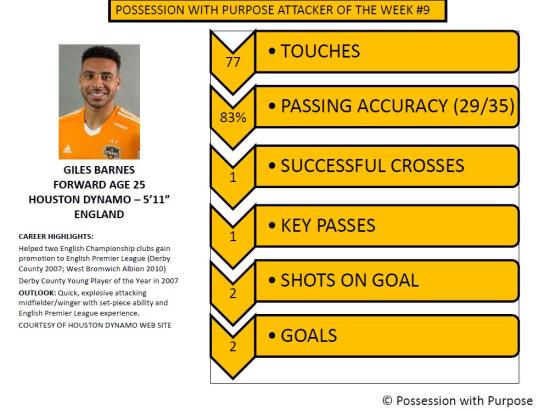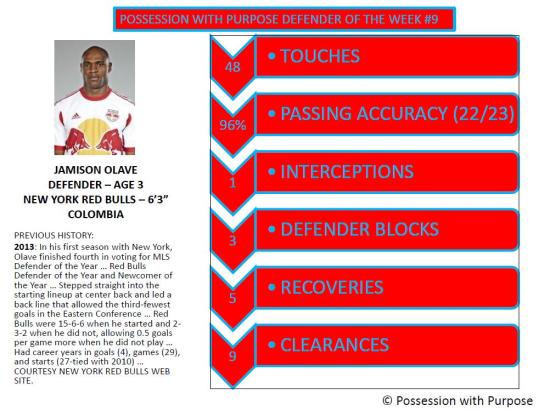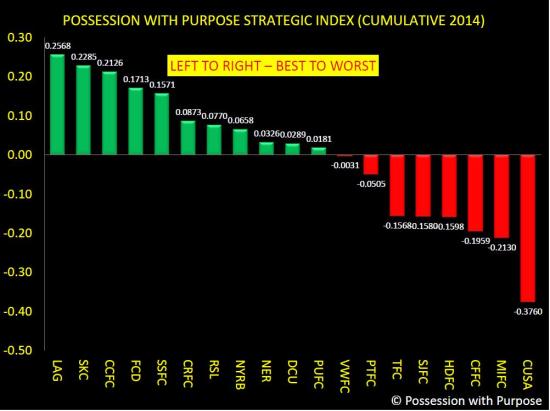Taking a team to L.A. and winning 4-1 sounds incredible until you offer up the caveat that it wasn't against the Galaxy.
The doormat this year seems to be shining earlier than last. The Houston Dynamo have dominated in dynamic fashion; wow - good on you Giles Barnes...
So how exactly did that powerful attack look compared to other four-goal outbursts this year - was it really that special?
In all the four-goal games this year, here's a quick breakdown on which teams accomplished that and then who's been tops in their Possession with Purpose and Expected Wins statistics for those games:
- DC United vs FC Dallas
- Sporting KC vs Montreal Impact
- Seattle Sounders vs Colorado Rapids
- Seattle Sounders vs Portland Timbers
- New York Red Bulls vs Houston Dynamo
- Houston Dynamo vs Chivas USA
- Houston Dynamo vs New England Revolution
- Portland Timbers vs Seattle Sounders
- Vancouver Whitecaps vs New York Red Bulls
Tops in overall possession in those high scoring affairs was DC United at 67.04%. Tops in passing accuracy across the entire pitch was, again, DC United at 84.17%.
Tops in penetration percentage based upon passes completed in the final third vs. across the entire pitch was Houston vs. New England at 28.94%.
Tops in percentage of successful passes within the final third was Vancouver at 74.55%. Tops in shots taken compared to passes completed in the final third was Houston vs. Chivas USA at 39.13%.
Tops in shots on goal compared to shots taken was Vancouver at 71.43%; and finally... tops in goals scored vs. shots on goal was FC Dallas at 100% versus Houston.
So while Houston did well this weekend, and got their second four-goal game, it wasn't dominating compared to others - sorry Houston. It was three points (which is the target) but it wasn't really that special when viewing who you played against... more later on just how weak Chivas are in Possession with Purpose.
However viewed, Houston still had the best attacking outcome this week. So here's my PWP Attacking Player of the Week... Giles Barnes.

Moving on to the Defensive side of the pitch - FC Dallas saw red this past weekend and it wasn't just their kit, the Red Bulls kit or Dax McCarty's hair - it was Watson (elementary my dear) who got red.
Things don't get better for Dallas either - they travel to Seattle for a midweek clash this Wednesday and then must fly down to San Jose for another on Saturday... wow. Might we see Dallas drop three in a row? I'm not sure and if you want to know my MLS picks for this week check here.
Anyhow, I digress - the PWP Defending Player of Week 9 is Jamison Olave...

So was that a worthy three points for New York and should it have been expected? I'm not sure and here's some information to consider:
Below is a list of games, this year, where the first team listed got a Red Card:
- DC United v FC Dallas
- Columbus Crew v DC United
- Columbus Crew v Sporting KC
- Sporting KC v Columbus Crew
- Sporting KC v New England Revolution
- Sporting KC v Real Salt Lake
- FC Dallas v Chivas USA
- FC Dallas v DC United
- FC Dallas v New York Red Bulls
- FC Dallas v Portland Timbers
- New York Red Bulls v Philadelphia Union
- Houston Dynamo v FC Dallas
- Houston Dynamo v Philadelphia Union
- Chivas USA v Houston Dynamo
- Chivas USA v San Jose Earthquakes
- Chivas USA v Seattle Sounders
- Chivas USA v Vancouver Whitecaps
- Portland Timbers v Colorado Rapids
- Portland Timbers v FC Dallas
- Vancouver Whitecaps v Colorado Rapids
- Colorado Rapids v Portland Timbers
- Colorado Rapids v Sporting KC
- Montreal Impact v Philadelphia Union
- Chicago Fire v New England Revolution
- Chicago Fire v Portland Timbers
- San Jose Earthquakes v Colorado Rapids
- Seattle Sounders v Columbus Crew
Twenty seven in all and only Colorado, New York, FC Dallas twice, Sporting KC and DC United won games yielding just a 22% chance of winning when seeing Red.
FC Dallas and Chivas USA lead MLS having received Red Cards in four games. But here's where the more later comes in for Chivas - check this out.
FC Dallas (when short handed) have an Attacking PWP Index = 2.3976. Their Defending PWP Index = 2.3914 and their Composite PWP Index = .1472.
By contrast, the Goats PWP Indices (at full strength this year) for Attacking = 2.1685; for Defending = 2.5446 and for Composite PWP = -.3760. If I were a Chivas USA supporter that is a pretty depressing statistical output - FC Dallas, short-handed, are more productive in Attack and more effective in Defense than a full-strength Chivas... wow!
In circling back to my question on whether or not it should have been expected that New York would win? Perhaps now, seeing how effective FC Dallas is, even when short-handed, it wasn't quite the cake-walk one would expect. Key for Dallas these next 7 days will be the health of Diaz and the discipline to minimize Red Cards...
In closing...
After nine full weeks of MLS here's how things stand with my Composite PWP Index along with a few quick thoughts plus the Top 3 in Attacking and Top 3 in Defending.

LA Galaxy remain atop the table even with their 1-nil loss in Colorado - if Robbie Keane hits that PK, LA doesn't drop one point. As for Columbus they drop down to 3rd with Sporting KC pushing up to spot #2.
Seattle, FC Dallas, Colorado and Columbus still stay in the top 6 while RSL continues to move forward - inching one space higher into 7th with New York and New England swapping places.
Note DC United dropped a few places and the bandwidth between the Revolution, United, Union, Whitecaps, and Portland got a bit tighter while Houston pushed forward past both Montreal and Chicago after thrashing Chivas.
Settling into last is Chivas, by a large margin, while the Fire and Impact hover on the low end as well...
Did a change in Managers (Head Coaches) really make a difference when looking at the End State? I'm not sure; for now it doesn't appear that either Klopas or Yallop have really changed things up when viewing the bottom line...
The top three teams in overall Attacking PWP (after 9 full weeks) are FC Dallas, Seattle Sounders, and Columbus Crew - can their approaches in possession continue to keep them there?
The top three teams in overall Defending PWP are Sporting KC, LA Galaxy and New England Revolution - some might offer elsewhere that it is surprising to see the Revolution somewhat higher in the table compared to others; is that surprising?
I don't think so... they have shown pedigree in defending for over a year now and with an improved attack it only stands to reason that their overall position finds them where they are...
Finally, have you made adjustments in your Fantasy teams yet?
If not and you are looking for a consistent (team back-four) you may want to add the Revolution to your list while spending a bit of change in leveraging Lloyd Sam from New York (cheap and cheerful) or latching on to Jaoa Plata if you haven't already...
Best, Chris










